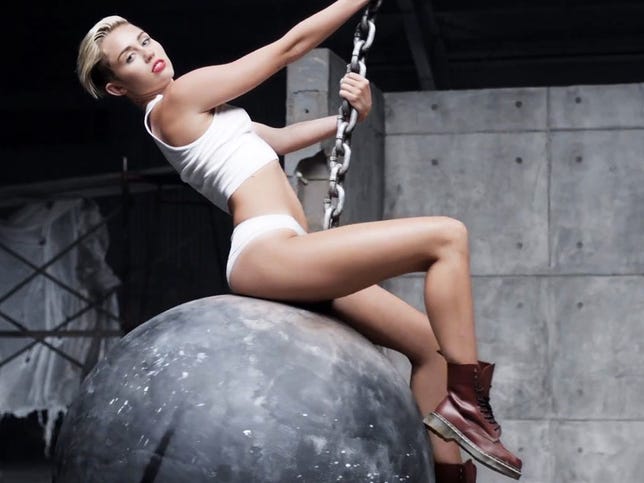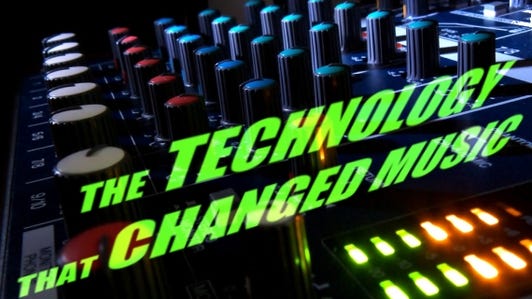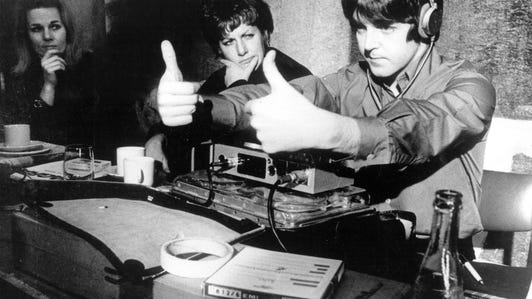
Miley Cyrus Vevo
Good evening YouTube — are you ready to rock? Probably the world’s biggest platform for fans finding and playing music, new and old, the Google-owned video website is a perfect place to reach fans across the world. So if you’re an artist, band or record label, here’s how to hit the high notes on YouTube.
These tips for making the most of YouTube come from Gideon Mountford, Head of Video for Believe Digital, speaking at music industry conference Sound City in Liverpool, UK. Believe is a multichannel network (MCN), a digital distributor that helps artists, labels and the people who hold the copyrights to music to distribute their work across the Web’s various platforms and earn money from doing so.
So how do you rock YouTube? Ah-one, two, ah-one-two-three-four!
Channel your energy
The first thing you need to do is create an official channel for your band or label, so fans can search for the name and find all your videos in one place. And when you have your own channel, you can define each video as official, which means YouTube’s search algorithm prioritises it over fan videos.
As well as being a place to post your official videos, the channel gives you an opportunity to interact with fans and other channels to keep people thinking about you even when you don’t have a new song. “What we’re trying to do is take a viewer and convert them into a subscriber,” says Mountford. If you can get someone who watched one video to subscribe to your channel they’ll see all your new stuff as you post it, racking up your view count — which makes you look popular — and your advertising revenue — which pays for new guitars, spangly shoes, Jack Daniel’s and other musical essentials.
For instructions on how to create a channel — or anything else you want to do — check out YouTube’s handy help section, packed with useful video tutorials on everything from managing your channel to copyright disputes.
Stick to a schedule
“One of the key things we say to rights holders, channels and labels is you need to have a programming schedule,” says Mountford. “There’s no point in having a channel and not doing anything with it.” Remember, you want people to subscribe, and they need to be be tempted with the promise of more cool stuff to watch.
From wax cylinders to Auto-Tune: The technology that changed music






+33 more
Although it depends on the artist and the amount of content available, Mountford recommends a new piece of content at least every other week, and some sort of activity — commenting on other videos, say, or creating a playlist — every week. “If you were working with an artist and they didn’t have any content for another two months,” suggests Mountford, “you can work with them on creating a playlist to the best music of the summer or music they’re influenced by.”
Stop, collaborate and listen
Another way of getting out there is to work with other channels. Mountford suggests branded aggregator channels such as dance-focused channel Eton Messy, session-focused La Blogotheque, or Majestic Casual are a “very effective way for building an audience.”
“The issue for rights holders,” he cautions, “is these channels want to monetise this content so if a video gets 10 million views you won’t see any of the money from that…for rights holders it’s a balancing act deciding what you want to do if you’re approached by these channels. One way of doing it is to work on a promotion that links back to the content, like a B-side.”
Earn money from your music
Let’s get down to the nitty-gritty: moolah, wonga, cash money. If you’re a band, artist, record label or other rights holder you can earn money when adverts are shown in front of videos that feature your songs. You can even earn money from videos that were uploaded by someone else, but we’ll get to that in a second.
How much will you earn? It’s impossible to say, as there’s no single flat rate. The value of a view depends on various factors such as where the viewer lives — a viewer in Western Europe earns you more than, say, a viewer in Thailand, because of the differences in the advertising markets in different regions. Mountford suggests that as a general rule of thumb videos could earn between $1 and $8 every thousand times they’re viewed (that converts to around 65p-£5.20, or AU$1.30-AU$10.30) but due to all the variables involved, the rate will vary.
A note of caution: ad revenue is great if you’re Taylor Swift, whose “Blank Space” video is heading for a billion views, but smaller acts won’t see anywhere near as many views and may not earn much. Even if people are watching your videos, not all of those viewers will see an advert, so a single play might earn you nothing. Some countries aren’t monetised at all; and in Germany, YouTube doesn’t have a deal with the music rights collection society so all videos designated as music videos are blocked. “You can call it something else in the meta data,” says Mountford, “but it counts as a different type of video and we don’t recommend that.”
The other danger is that people will listen to your song by watching on YouTube instead of going to iTunes, Spotify or another service and paying for it. But with a billion people watching videos, it’s a marketing tool that can’t be ignored.
Use Content ID to earn money from other videos
Anybody can post a video on YouTube — whether it’s a clip of a dog chasing deer or an official star-studded multimillion dollar music video — and in practice many videos are a bit of both, as fans upload videos using music by the bands they love. These can be creative homages, like fans remixing or covering a song, or setting their favourite band’s music to creative visuals. Often though, it might be a packshot video (a still picture of the record artwork) that straight-up rips off a song to garner views for the uploader’s own channel.
To make sure the right person gets paid, YouTube has a system called Content ID that essentially finds all videos using a particular piece of music and gives the music’s actual rights holder some control over the video, no matter who uploaded it. Let’s let YouTube explain:
Mountford estimates that Content ID is 90 per cent effective at finding and monetising content that’s been ripped off elsewhere. As the rights holder, you can choose to block the rip-off videos so only your official version gets the views, giving you a more impressive play count to show off to the press and fans.
Alternatively you can allow the rip-offs, which Mountford recommends for older songs so they still appear in existing playlists and embedded in websites. That’s good for keeping people thinking about the band — and, more usefully, if you do allow those videos, YouTube funnels you the ad money each time someone plays the video.
Bear in mind that you can only earn money from a video once you’ve laid claim to it; you can’t backdate revenue.
To sign up to Content ID, visit youtube.com/content_id_signup.
Don’t try to buy views
It’s possible to pay for loads of extra views to boost your play counts. But like white lines, the advice is clear: don’t do it. “YouTube has a lot of spiders that pick up that views are fake,” says Mountford. “YouTube will spot this and pull down the video and give the channel a copyright strike or even shut the channel down.”
Think about length
Mountford stresses that in this age of distractions when 50 per cent of videos are watched on a mobile device, your video shouldn’t be backwards in coming forwards. “Make sure that the opening of your video comes straight to the point because it’s really key that a viewer keeps watching.”
Speaking at another Sound City panel, Facebook’s Niall Fagan revealed that “78 per cent of people are impressed upon after 10 seconds of video, so 10 seconds of video is the optimum amount of time for somebody to remember you.” But you still want them to stick around. “If someone clicks on a video and watches it for only 10 seconds,” Mountford warns, “YouTube will look at that video and say people don’t want to watch that, we’re not going to show it in search.”
That doesn’t mean every video has to be over quickly. Quite the opposite: Mountford asserts that a subscriber watches on average for an hour per day, and 40 per cent of videos are longer than 20 minutes. Longer videos can even be prioritised by YouTube’s search algorithm, which favours longer watch times. If you’re struggling to come up with something lengthy, it’s OK to combine shorter videos into a longer watch: “repackaging content is a great way to reach your audience,” says Mountford.
Make different stuff as well as music videos
The obvious type of video for a band is a traditional music video. But few bands can keep churning out full-blown new songs and promo clips every five minutes. “It’s a really bad approach to only upload content when there’s a release,” says Mountford. So what can you do between releases?
Other examples of possible types of videos given by Mountford include behind-the-scenes videos, interactive music videos or timeline videos for classic acts like 70s Swedish sensations Abba.
See what your fans want
For ideas about different videos, look to your audience. Fans typically make the videos they want to see, so you can look at what fans are doing with your songs on YouTube to find out what they’d be interested in. Mountford asserts that, “If you type any track into the YouTube search box the first one you’ll find will be the official video, the second will be a lyric video…We noticed for [70s and 80s British rock band] Queen every track has a lyric video. That shows us that people want to see those videos. But those people are watching your content on fan channels.”
“[Australian rock band] AC/DC doesn’t have any lyric videos, so lots of their fans are watching their content but not on their channel, so they’re not making any money from it. [US pop-punk band] Fall Out Boy’s fans are making long-form videos, but the band hadn’t done that on their own channels.”
Name and tag your videos properly
You’ve written a killer song and you’ve made an innovative music video. But before you pass round a celebratory bottle of Jack and a mirror, there’s some admin to do to make sure your masterpiece reaches as many people as possible and gets you paid.
“YouTube’s algorithm wants to show the video it’s confident the person searching wants to see, so it looks at four elements,” says Mountford. And they are: title, description, tags and metadata.
The first thing to get right is the video’s title, which must contain the both the artist’s and the track’s name. “It seems obvious,” says Mountford, “but a lot of videos, especially from the majors, don’t have the artist name in.”
Next, the description. “Ask people to subscribe in the description,” advises Mountford. “We work with Queen and they had a very low number of subscribers. All we did was ask people to subscribe and we got a massive uplift in subscribers. Ask people to do something and they’ll do it!”
Tags are useful to help fans find the next video. “Use a generic set of tags across all your videos so YouTube groups them together,” suggests Mountford, such as the genre your band falls into, or the name of the record label.
Press play on YouTube
- YouTube turns 10: The video site that went viral
- Generation YouTube: Today’s fastest-rising stars aren’t coming out of Hollywood
- The surprising rise of YouTube lyrics videos
- YouTube’s Music Key: Can paid streaming finally hook the masses?
Metadata is less visible but is crucial to make sure you get paid. “A lot of what we do is cleaning up metadata,” says Mountford, “such as when videos are in conflict to make sure they’re being monetised correctly.”
Give your thumbnail the thumbs-up
On YouTube’s crowded search page, your video’s thumbnail needs to draw the eye. “Use contrast colours,” suggests Mountford — “and check how it looks on a mobile.”
“Big channels like MixMag or Majestic Casual have a watermark,” Mountford points out, “so someone searching can see that watermark and know what type of video that is, and think ‘I’ve watched them before’, and they’ll click on the video.”
Watermark and annotate your videos
“A hover-over watermark is a very effective way to turn viewers into subscribers,” says Mountford. “You only have to set it up once and it’s across all videos.”
You can also annotate individual videos. The Abba video above is one clever use of annotations, or you can use them to ask your viewer to put their money where their mouse is. “The most effective place to place an annotation is at the end of the video. If someone has sat through a 3-minute video, they’re engaged and you can ask them to subscribe or buy a ticket to the show.”
Know your copyrights
There are various different types of copyright each protecting the different elements of a song, so you have to be careful not to be caught out. For example, says Mountford, “if you’re creating a lyric video you need permission from the publisher.”
Getting copyright wrong can have dire consequences for your channel or your band. Mountford warns that, “A copyright dispute can lead to delay or denial of monetisation, removal of access to features, or even the termination of your account and lawsuits.”
Think about where else you can promote yourself
These methods of driving fan engagement — marketing speak for keeping ’em interested — holds true for various platforms, not just YouTube. At similar conference the Great Escape in Brighton, UK, just last week, industry insiders including Spotify’s director of label relations discussed how bonus content like this help to keep fans listening to an artist or band’s music on streaming services for longer. When it comes to bonus content, think playlists and audio commentaries.
YouTube, Spotify and the future of the music industry
- ‘We tell Spotify no, YouTube does it anyway’: The music industry’s love-hate relationship with YouTube
- Streaming may save record industry, says one insider
- The new Spotify: Part tunes, part TV, part fortune-teller
- All those ‘Likes’ don’t add up to real fans, Facebook exec warns brands
Other video platforms are available, such as DailyMotion, Muzu.TV, Germany’s MyVideo, France’s La Virgule and Yahoo. Many music videos appearing on YouTube come via Vevo because it’s part-owned by two of the three major labels, Universal and Sony, but Mountford bemoans that the service has “a lot of hoops you have to jump through” when posting videos, compared to the simpler tools provided by YouTube.
Meanwhile Spotify video was announced last month. Mountford’s company Believe hasn’t made any plans for working with Spotify’s new service, but he is welcoming of a wide range of players in the video game: “It’s not a drawback for our clients if they’re on different services. We might run exclusives on either service for a week…we want to work with as many platforms as we can.”
While these rival video platforms are good for getting exposure by getting bands in front of viewers, they’re not a patch on YouTube for monetising your content. Take Facebook: the social network has a vast potential audience of 1.44 billion people to watch videos, but it doesn’t feed any revenue at all back to rights holders.
For Mountford that’s led to “a constant battle for labels to decide whether to go with YouTube or Facebook.” A good current compromise is for artists and labels to post short teaser videos on Facebook, similar to movie trailers, that “send people to the proper video in YouTube where artists and labels are able to generate revenue.”
Or just let someone else do the work
One way of being successful on YouTube is to let someone else do it for you. You could sign up to a multichannel network (MCN) like Believe Digital, or a rival such as Rightster’s Base79, which help artists and labels benefit from YouTube in various ways.
“Believe Digital are one of the largest partners on YouTube for music labels and artists, generating over 3 billion monthly views,” Mountford boasts. “We offer a tailored service in order to significantly grow revenues and audiences.” The MCN takes a share of the revenue earned from monetising your music and videos depending on what level of service you opt for.
“The focus of our work is split into the following areas: rights management, monetisation, audience development, production and cross-promotion. The service we provide allows our labels and artists to focus on the creative aspects of video strategy, allowing Believe Digital to focus our attention on increasing all the key metrics of our clients’ channels.”
In other words, they let you focus on rockin’ out.
Hope you found those tips useful. Thank you YouTube and goodnight!




